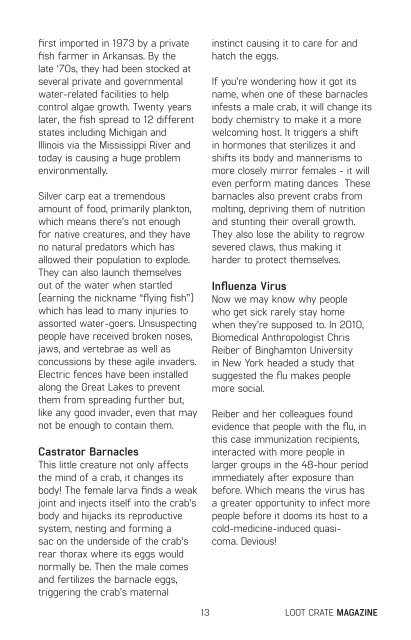Loot+Crate+Magazine+January+2016
Create successful ePaper yourself
Turn your PDF publications into a flip-book with our unique Google optimized e-Paper software.
first imported in 1973 by a private<br />
fish farmer in Arkansas. By the<br />
late ‘70s, they had been stocked at<br />
several private and governmental<br />
water-related facilities to help<br />
control algae growth. Twenty years<br />
later, the fish spread to 12 different<br />
states including Michigan and<br />
Illinois via the Mississippi River and<br />
today is causing a huge problem<br />
environmentally.<br />
Silver carp eat a tremendous<br />
amount of food, primarily plankton,<br />
which means there’s not enough<br />
for native creatures, and they have<br />
no natural predators which has<br />
allowed their population to explode.<br />
They can also launch themselves<br />
out of the water when startled<br />
(earning the nickname “flying fish”)<br />
which has lead to many injuries to<br />
assorted water-goers. Unsuspecting<br />
people have received broken noses,<br />
jaws, and vertebrae as well as<br />
concussions by these agile invaders.<br />
Electric fences have been installed<br />
along the Great Lakes to prevent<br />
them from spreading further but,<br />
like any good invader, even that may<br />
not be enough to contain them.<br />
Castrator Barnacles<br />
This little creature not only affects<br />
the mind of a crab, it changes its<br />
body! The female larva finds a weak<br />
joint and injects itself into the crab’s<br />
body and hijacks its reproductive<br />
system, nesting and forming a<br />
sac on the underside of the crab’s<br />
rear thorax where its eggs would<br />
normally be. Then the male comes<br />
and fertilizes the barnacle eggs,<br />
triggering the crab’s maternal<br />
instinct causing it to care for and<br />
hatch the eggs.<br />
If you’re wondering how it got its<br />
name, when one of these barnacles<br />
infests a male crab, it will change its<br />
body chemistry to make it a more<br />
welcoming host. It triggers a shift<br />
in hormones that sterilizes it and<br />
shifts its body and mannerisms to<br />
more closely mirror females - it will<br />
even perform mating dances These<br />
barnacles also prevent crabs from<br />
molting, depriving them of nutrition<br />
and stunting their overall growth.<br />
They also lose the ability to regrow<br />
severed claws, thus making it<br />
harder to protect themselves.<br />
Influenza Virus<br />
Now we may know why people<br />
who get sick rarely stay home<br />
when they’re supposed to. In 2010,<br />
Biomedical Anthropologist Chris<br />
Reiber of Binghamton University<br />
in New York headed a study that<br />
suggested the flu makes people<br />
more social.<br />
Reiber and her colleagues found<br />
evidence that people with the flu, in<br />
this case immunization recipients,<br />
interacted with more people in<br />
larger groups in the 48-hour period<br />
immediately after exposure than<br />
before. Which means the virus has<br />
a greater opportunity to infect more<br />
people before it dooms its host to a<br />
cold-medicine-induced quasicoma.<br />
Devious!<br />
13<br />
LOOT CRATE MAGAZINE


